
Eccleshall Castle is located in Eccleshall, Staffordshire, England (grid reference SJ827295 ). It was originally built in the 13th century. It is a Scheduled Ancient Monument and a Grade II* listed building.

Eccleshall Castle is located in Eccleshall, Staffordshire, England (grid reference SJ827295 ). It was originally built in the 13th century. It is a Scheduled Ancient Monument and a Grade II* listed building.
The land was reputedly granted to St Chad, the medieval bishop of Lichfield. In 1200 Bishop Geoffrey de Muschamp was granted by King John a ‘licence to crenellate’ a castle. [1] As Eccleshall was conveniently situated on the main road between the centres of the Lichfield diocese in Chester, Lichfield and Coventry it was an ideal location as a diocesan base. This original castle was replaced by a larger castle in 1305 by Bishop Walter Langton, Chancellor of England. [2]
At the outbreak of the Wars of the Roses, Margaret of Anjou, Queen consort of Henry VI, took refuge within the castle after the Battle of Blore Heath in 1459. [2]
In June 1643 the castle was besieged by Sir William Brereton and his Parliamentary forces encamped around the church. Their guns caused considerable damage to the walls but the castle held out, with Bishop Robert Wright sheltering within. When the Parliamentary forces finally took the castle on August 30 they found that the bishop had died of a heart attack during the siege and most of the defenders were either drunk or had gone into town drinking in the taverns. The castle was slighted to prevent future use as a stronghold but enough of the building, including an unusual nine-sided tower, together with the moat walls and medieval bridge, remained to be used as a prison for Royalist gentry. The castle and its grounds were confiscated and sold, but bought back again by the diocese.
The present house, still known as Eccleshall Castle, was built amongst the ruins in 1693 by William Lloyd, Bishop of Lichfield and Coventry, incorporating fragments of the slighted 14th-century structure, and was also occupied by successive bishops of Lichfield. Sir Walter Scott often stayed at the castle as guest of then bishop, James Cornwallis. [3] In the 18th century the gatehouse was demolished and the moat drained. The last bishop to live there was John Lonsdale, who died in the house in 1867. [2]
The Castle is now in private hands and closed to the public, although the gardens are occasionally opened to raise money for local Eccleshall charities as well as for occasional weddings. It has been the home of the Carter-Motley family for more than a hundred years. [2]

Lichfield Cathedral is an Anglican cathedral in Lichfield, Staffordshire, England, one of only three cathedrals in the United Kingdom with three spires, and the only medieval one of the three. It is the cathedral of the Diocese of Lichfield, which covers Staffordshire, much of Shropshire, and parts of the Black Country and West Midlands. It is the seat of the Bishop of Lichfield, currently Michael Ipgrave, who was appointed in 2016. It is a Grade I listed building.

Tamworth Castle, a Grade I listed building, is a Norman castle overlooking the mouth of the River Anker into the Tame in the town of Tamworth in Staffordshire, England. Before boundary changes in 1889, however, the castle was within the edge of Warwickshire while most of the town belonged to Staffordshire.

Eccleshall is a town and civil parish in the Stafford district, in the county of Staffordshire, England. It is located seven miles northwest of Stafford, and six miles west-southwest of Stone. Eccleshall is twinned with Sancerre in France.
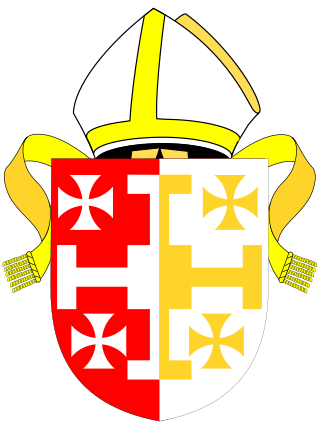
The Diocese of Lichfield is a Church of England diocese in the Province of Canterbury, England. The bishop's seat is located in the Cathedral Church of the Blessed Virgin Mary and Saint Chad in the city of Lichfield. The diocese covers 4,516 km2 (1,744 sq mi) of several counties: almost all of Staffordshire, northern Shropshire, a significant portion of the West Midlands, and very small portions of Warwickshire and Powys (Wales).

Walter Langton of Castle Ashby in Northamptonshire, was Bishop of Coventry and Lichfield and King's Treasurer. The life of Langton was strongly influenced by his uncle William Langton, Archbishop of York-elect, by Robert Burnell, Lord Chancellor of England and then by the years in which he served King Edward I. Lichfield Cathedral was improved and enriched at his expense.
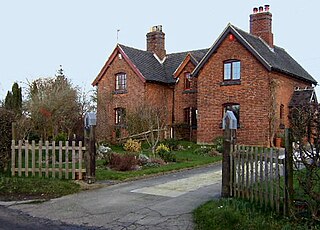
Barton Blount is a village and civil parish in the South Derbyshire district of Derbyshire, England, between Derby and Uttoxeter. According to the 2001 census it had a population of 74. The population remained at fewer than 100 for the 2011 Census. Details are included in the civil parish of Church Broughton.

Robert Wright (1560–1643) was an English bishop, first holding the see of Bristol and then the see of Lichfield and Coventry. He died at an episcopal palace, under siege in the First English Civil War.
Geoffrey de Muschamp was a medieval Bishop of Coventry.

Dudley Priory is a dissolved priory in Dudley, West Midlands, England. The ruins of the priory are located within Priory Park, alongside the Priory Estate, and is both a scheduled monument and Grade I listed. The ruins received this status on 14 September 1949.

Ellenhall is a small Staffordshire village roughly 2.5 miles south of Eccleshall originally comprising part of the extensive estates of the Earl of Lichfield. The population as taken at the 2011 census was 144. The village consists of a scattered community of cottages, a hall, and several farms. Ellenhall has no shop, public house or post office.
William Overton was an English bishop.
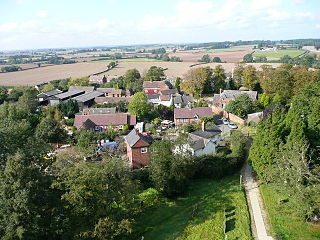
Clifton Campville is a village, former manor and civil parish in Staffordshire, England. It lies on the River Mease, about 10 miles (16 km) east of the City of Lichfield, 6 miles (10 km) west of Measham and 7 miles (11 km) north of Tamworth. The village lies close to Staffordshire's borders with Derbyshire, Leicestershire and Warwickshire. The parish, which includes Haunton village, had a population of 912 at the 2011 census. There is a fine gothic church, dedicated to St Andrew, and listed Grade I. The village pub, The Green Man, is also a historic building.

The Hospital of St John Baptist without the Barrs is a building with an adjacent chapel in the city of Lichfield, Staffordshire, England. It is a Grade I listed building.

The Bishop's Palace is a 17th-century building situated in the north-east corner of the Cathedral Close in Lichfield, Staffordshire in England.

Caludon Castle is a Scheduled Ancient Monument and Grade I listed building in Coventry, in the West Midlands of England. A second moated site 190 metres (620 ft) to the south is a Scheduled Ancient Monument in its own right. The castle is now a ruin, and all that remains is a large fragment of sandstone wall. What remains of the estate is now an urban park, owned and run by Coventry City Council, but much of it was sold and developed into housing estates in the early 20th century.
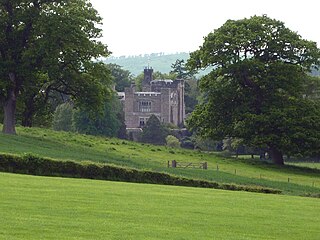
Thurland Castle is a country house in Lancashire, England which has been converted into apartments. Surrounded by a moat, and located in parkland, it was originally a defensive structure, one of a number of castles in the Lune Valley. It is recorded in the National Heritage List for England as a designated Grade II* listed building. Situated between the villages of Cantsfield and Tunstall the castle stands on a low mound on a flat plain, with the River Greta on the south side and the Cant beck to the north. A deep circular moat surrounds it.

Holy Trinity Church in Eccleshall, Staffordshire, England, is a Grade I listed Anglican church.

Hen Gwrt,, Llantilio Crossenny, Monmouthshire is the site of a thirteenth century manor house and a sixteenth century hunting lodge. Originally constructed for the Bishops of Llandaff, it subsequently came into the possession of the Herberts of Raglan Castle. The bishops constructed a substantial manor house on the site in the thirteenth century, which was moated in the fourteenth. The building was then adapted by the Herberts to create a lodge within their extensive hunting grounds. The lodge continued in use until the slighting of Raglan Castle in the English Civil War.
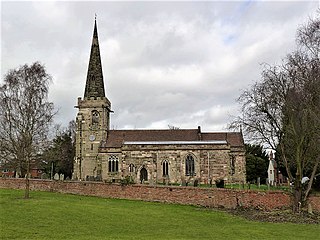
St Mary's Church is a parish church of the Church of England in Rolleston on Dove, Staffordshire. Parts of the structure date to 1130, though it was extensively renovated in 1892. It is unusual in having the main entrance door on the north side, with the southern entrance reserved for members of the Mosley family, local landowners and key donors to the church. The church features stained glass windows dating to the medieval period and others by Victorian designer Charles Eamer Kempe. The tower houses eight bells, one dating to 1586. The church is grade I listed and there are associated grade II listings for churchyard railings, a memorial, the lychgate and a former church grammar school. The lychgate, by Lincolnshire architect Cecil Greenwood Hare, also functions as a war memorial.

Eagle House is a Grade II listed building in the Staffordshire town of Eccleshall, England, which is currently an award winning bed and breakfast.